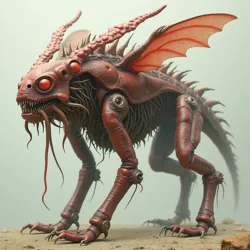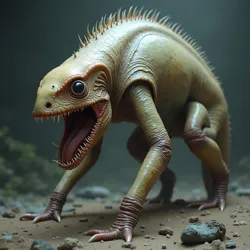Post-Catalysm Xenofauna

Diverse and strange animal life forms with significant biological and morphological alterations after a global environmental disruption.
Post-Catalysm Xenofauna
Animal life altered after Catalysm
Mutagenic agents, accelerated adaptation
Novel physiology, altered size, new organs
Reshaped ecosystems, new niches
Threat, resource, coexistence
*Post-Catalysm Xenofauna* refers collectively to the diverse array of animal life forms that have undergone significant biological and morphological alterations following the global environmental disruption known as The Catalysm. These organisms exhibit characteristics that deviate markedly from their pre-Catalysm ancestors, often displaying novel physiologies, enhanced or diminished sizes, redundant or malformed anatomy, and entirely new biological functions. The emergence of Post-Catalysm Xenofauna is a defining ecological feature of the present era, reshaping ecosystems and posing significant challenges and sometimes opportunities for surviving human populations. Their study involves understanding the complex interplay of environmental stressors, genetic instability, and accelerated evolutionary processes that have driven these transformations.
The term "Xenofauna" emphasizes their departure from familiar biological norms, highlighting the "alien" or "strange" nature of their post-mutational forms. While some species exhibit only minor variations from baseline morphology, others are so profoundly changed that identifying their ancestral lineage requires detailed genetic or anatomical analysis. These changes are not merely adaptations in the conventional sense, though adaptive pressure certainly plays a role in the survival and proliferation of altered forms; rather, they are often the direct result of Pervasive mutagenic agents introduced into the biosphere or triggered by the Cascading environmental collapse that followed the Catalysm. The study of these creatures provides critical insights into the resilience and fragility of life, the long-term impacts of widespread environmental contamination, and the unpredictable pathways of biological change under extreme pressure.
Origins and Etiology
The proliferation of Post-Catalysm Xenofauna is primarily attributed to the widespread release and persistence of potent mutagenic agents throughout the environment during and after the Catalysm. These agents acted upon the genetic material of organisms across the planet, disrupting normal cellular processes and introducing errors into the DNA sequence at an unprecedented rate. The effects were manifold, ranging from immediate cellular death and developmental failure to subtle changes that manifested in later generations or under specific environmental conditions. Understanding the specific causes of mutation is crucial for predicting the distribution and characteristics of different Xenofauna types, as well as for developing strategies for survival and, in some cases, mitigation.
The environmental conditions following the Catalysm were highly varied depending on the specific locale, leading to different primary drivers of mutation in different regions. Areas subjected to direct high-energy releases experienced intense radiation fields, while others were inundated with novel chemical compounds or exposed to engineered biological vectors that proved highly mutagenic. The scale of the disruption meant that few, if any, environments remained entirely untouched by at least one form of potent mutagen, leading to a global phenomenon of biological alteration.
Radiation Exposure
High-intensity ionizing radiation was a primary mutagenic force in regions directly impacted by the energetic events of the Catalysm, or in areas where radioactive materials were dispersed. Radiation damages DNA by causing strand breaks, base modifications, and cross-links. While living cells possess repair mechanisms, overwhelming exposure or specific types of damage can lead to misrepair or unrepaired lesions, resulting in permanent mutations. These mutations can affect somatic cells, leading to tumors or physiological dysfunction within an individual, or germline cells, which pass mutations onto offspring.
The types of radiation involved varied, including alpha, beta, gamma, and neutron radiation, each with different penetration capabilities and biological effects. Lingering radioactive isotopes in the soil, water, and air continue to contribute to background radiation levels in certain [Mutagenic Hot Zones], causing ongoing genetic damage across successive generations. Studies in regions with persistent high radiation, conceptually similar to the long-term ecological monitoring conducted in the [Chernobyl Exclusion Zone] after the 1986 disaster, have shown elevated mutation rates, increased occurrences of developmental abnormalities, and changes in species composition and population dynamics. The effects are often dose-dependent and cumulative, meaning that even lower levels of exposure over extended periods can induce significant genetic drift within populations.
Chemical Mutagenesis
Beyond radiation, the Catalysm involved the release of vast quantities of synthetic chemicals, industrial byproducts, and novel compounds into the environment. Many of these substances act as chemical mutagens, interacting directly with DNA or the cellular machinery responsible for DNA replication and repair. Alkylating agents, intercalating agents, and base analogues are examples of chemical classes known to induce mutations by altering DNA structure or interfering with accurate copying during cell division. These chemicals permeated ecosystems, contaminating water sources, soils, and the food chain.
Unlike localized radiation events, chemical contamination is often diffuse and persistent, leaching through groundwaters and accumulating in organisms through bioaccumulation. This widespread exposure means that even species in areas not directly hit by the Catalysm's initial energy releases could be affected by secondary chemical pollutants. The synergistic effects of multiple chemical agents, or the combined impact of chemical exposure and lower-level radiation, can amplify mutagenic effects, leading to complex and unpredictable alterations in affected organisms. Research into the long-term effects of industrial pollution on wildlife, such as studies near heavily contaminated sites, provides a comparative framework for understanding the pervasive impact of post-Catalysm Chemical Mutagenesis.
Accelerated Adaptation
While direct mutagenesis from radiation and chemicals accounts for many of the dramatic alterations seen in Post-Catalysm Xenofauna, the extreme environmental pressures of the post-Catalysm world also drove rapid selection for traits that enhanced survival. Organisms with pre-existing genetic variations that conferred tolerance to toxins, resistance to disease, or enhanced ability to exploit novel resources were more likely to survive and reproduce. Furthermore, the high mutation rate itself provided a larger pool of genetic variation upon which natural selection could act.
This accelerated adaptation is distinct from direct mutation, representing the selective sorting of genetic changes that improve fitness in the harsh new environment. Species that could rapidly adapt to altered climates, contaminated food sources, increased predation pressure from newly emerged apex predators, or competition from other altered species were more likely to persist. This process is conceptually similar to the rapid evolution observed in some organisms exposed to pollutants or antibiotics in the real world, albeit occurring on a much larger scale and against a backdrop of continuous genetic perturbation. The combination of high mutation rates and intense selective pressure has led to the rapid emergence of highly specialized and often bizarrely adapted forms, occupying ecological niches that did not exist before the Catalysm.
Classification and Morphology
Classifying Post-Catalysm Xenofauna is a complex and ongoing challenge. Traditional taxonomic methods based on shared ancestry are complicated by the rapid and often convergent evolution of similar traits in unrelated lineages, as well as the difficulty in tracing the lineage of heavily mutated forms. Current approaches often combine genetic analysis (when possible), morphological comparison, ecological niche, and observed behavior to group and understand these altered creatures. No single, universally accepted classification system exists, and regional taxonomies often focus on characteristics most relevant to human interaction, such as danger level or resource potential.
 Mutated creatures exhibiting extreme size differences compared to their ancestors, including examples of gigantism and dwarfism.
Mutated creatures exhibiting extreme size differences compared to their ancestors, including examples of gigantism and dwarfism.Morphological changes are perhaps the most immediately striking feature of Post-Catalysm Xenofauna. These alterations can manifest across every biological system, from the integumentary and skeletal structures to internal organs and metabolic pathways. Some changes appear to be direct, often deleterious, results of genetic damage, while others seem to represent novel adaptations, albeit ones that arose from a foundation of genetic instability. The scale of these changes varies immensely, from subtle shifts in coloration or size to the development of entirely new limbs, sensory organs, or biological functions.
Size Aberrations
One of the most commonly observed types of morphological change in Post-Catalysm Xenofauna is significant deviation in size compared to their ancestral species. This can manifest as gigantism, where individuals or entire populations are substantially larger than normal, or dwarfism, where they are significantly smaller. Gigantism is often associated with specific types of endocrine disruption caused by mutagens or with ecological release in the absence of previous limiting factors. For example, the Crag-Striding Ursids, believed to be descended from various bear species, can reach sizes rivaling small elephants, their massive forms adapted for navigating treacherous post-Catalysm terrain.
Conversely, dwarfism can result from metabolic damage, nutritional deficiencies in contaminated environments, or selection pressure favouring smaller size for concealment or reduced resource needs. Populations of certain rodent species found within heavily contaminated urban ruins, for instance, are often significantly smaller than their pre-Catalysm counterparts, exhibiting rapid generation times but reduced individual resilience. These size aberrations fundamentally alter the creature's role in the ecosystem, changing predator-prey dynamics and resource consumption patterns.
Sensory Augmentations
Many Post-Catalysm Xenofauna exhibit altered or augmented sensory capabilities. This can include the development of new sensory organs or the significant enhancement of existing ones. Examples include canid descendants with enhanced olfactory sensitivity capable of detecting minute traces of substances across vast distances, or avian species with visual spectra shifted to perceive wavelengths outside the normal human range, perhaps useful for navigating areas with unusual atmospheric conditions. Some aquatic Xenofauna, the Murk-Dwellers of polluted waterways, have developed chemosensory organs that detect specific dissolved chemicals, allowing them to locate prey or avoid highly toxic zones.
Less common but more dramatic are creatures with entirely novel sensory apparatuses, such as organs that detect ambient radiation fields, electromagnetic fluctuations, or subtle seismic vibrations. These augmentations are often linked to survival in environments where traditional senses are unreliable or where new environmental cues are critical. The development of such complex structures from genetic damage highlights the unpredictable nature of mutation and the potential for novel biological solutions to extreme environmental challenges, albeit often alongside significant physiological costs or malformations elsewhere in the organism.
Novel Organ Systems
Perhaps the most striking characteristic of some Xenofauna is the presence of entirely novel biological functions or organ systems not found in their ancestral lineages. This can include the ability to produce bioluminescence, useful for communication or predation in perpetual darkness or murky conditions, as seen in the Glow-Worms of the Contaminated Flats. Other creatures have developed tissues capable of metabolizing or sequestering toxins, allowing them to thrive in polluted environments that would be lethal to other life forms. Some Xenofauna even possess limited forms of bioelectricity generation, used for stunning prey or defense.
The mechanisms behind the development of such novel systems are subjects of intense study. They likely involve complex interactions between multiple mutations affecting gene regulation and protein function, potentially reactivating dormant genetic pathways or co-opting existing genes for new purposes. While these novel systems can confer significant advantages, they often come at a high metabolic cost and can be associated with increased vulnerability to other environmental factors or diseases. The existence of such complex, emergent properties from the chaos of post-Catalysm mutation is a testament to the inherent potential for biological novelty, however distorted by the circumstances of its origin.
Ecology and Behavior
The emergence of Post-Catalysm Xenofauna has fundamentally restructured global ecosystems. Pre-Catalysm ecological relationships were shattered by the environmental collapse and the introduction of profoundly altered organisms. New food webs have formed, novel competitive dynamics have emerged, and the distribution and abundance of species are dictated by the patchiness of environmental contamination and the survival capabilities of the altered life forms. Understanding the ecology and behavior of these creatures is vital for predicting their impact on remaining resources, assessing threats to human settlements, and identifying potential ecological services they might provide.
Xenofauna occupy every conceivable ecological niche, from the apex predator to the detritivore. Their behavior is often modified from their ancestors, sometimes due to neurological damage caused by mutagens, but also as an adaptation to the new environmental context and their altered morphology and capabilities. Pack behaviors may be enhanced or abandoned, migratory patterns altered by impassable contaminated zones, and reproductive strategies shifted to cope with high infant mortality or unpredictable resource availability.
Niche Occupation
Post-Catalysm Xenofauna have rapidly filled or created new ecological niches. Areas with high radiation or chemical contamination, previously uninhabitable for most complex life, are now populated by extremophile Xenofauna capable of tolerating or even utilizing these conditions. The Murk-Dwellers, for instance, thrive in heavily polluted aquatic environments, feeding on organisms that have accumulated toxins and exhibiting resistance to chemical levels that would kill other creatures. In contrast, previously stable forest or grassland ecosystems, if less severely contaminated, might see native species replaced by faster-mutating, more adaptable forms that outcompete the originals.
The sheer variety of mutations means that specialized niches are common. Creatures with enhanced digging capabilities exploit unstable ground, while avian forms with altered wing structures or metabolisms dominate altered atmospheric zones. The interaction between different Xenofauna types also creates complex new dynamics; for example, a predator species might evolve specific resistances to the toxins produced by its preferred mutated prey. The ecological landscape is a mosaic of novel interactions, constantly shifting as mutations accumulate and environments continue to change.
Reproductive Strategies
Reproduction among Post-Catalysm Xenofauna often presents significant challenges due to genetic damage, physiological stress, and environmental hazards. Mutation rates are high, leading to a high frequency of non-viable offspring, developmental defects, and sterility in affected populations. To compensate for this, many Xenofauna species exhibit altered reproductive strategies compared to their ancestors. This can include increased clutch or litter sizes, accelerated maturation rates, or reduced parental investment in favor of producing more offspring.
Some species show novel reproductive adaptations, such as parthenogenesis (asexual reproduction) in populations where finding a viable mate is difficult due to low numbers or geographical isolation by hazardous zones. Others exhibit complex, altered mating rituals influenced by their new sensory capabilities or morphology. The viability of offspring is a major bottleneck for Xenofauna populations, and successful reproductive strategies are key to the persistence of altered lineages. The genetic load carried by many populations is immense, meaning that even seemingly healthy individuals may carry deleterious mutations that impact the health and viability of future generations.
Interspecies Dynamics
The interactions between different species of Post-Catalysm Xenofauna, as well as between Xenofauna and surviving pre-Catalysm organisms or human populations, are complex and often volatile. New predator-prey relationships are established based on the altered capabilities of the organisms. A small herbivore species might develop a tough, toxin-resistant hide that makes it inedible to its traditional predators, forcing those predators to seek new food sources or adapt themselves. Competition for resources is fierce, particularly in less contaminated areas where multiple altered species converge.
Symbiotic relationships, though less common than competitive or predatory ones, also exist. Certain microbial communities have co-evolved with Xenofauna, aiding in the detoxification of ingested materials or providing novel metabolic pathways. Parasitism is also prevalent, with mutated parasites exploiting the altered physiologies of their hosts. The overall interspecies dynamic is one of instability and rapid change, driven by ongoing mutation and adaptation. These dynamics are crucial for understanding the flow of energy and matter through post-Catalysm ecosystems and for predicting how changes in one population might cascade through the wider biological community.
Interaction with Human Populations
The relationship between surviving human populations and Post-Catalysm Xenofauna is multifaceted, characterized by conflict, cautious coexistence, and occasional attempts at exploitation or understanding. Xenofauna represent both a significant threat to human settlements and, in some cases, a potential resource or a subject of scientific inquiry. Human strategies for dealing with these creatures range from active eradication and containment to avoidance and, rarely, integration.
 Human survivors defending a settlement against dangerous mutated animals using reinforced barriers and weaponry.
Human survivors defending a settlement against dangerous mutated animals using reinforced barriers and weaponry.The presence of dangerous Xenofauna is a primary factor shaping the location, structure, and defense of human settlements in the post-Catalysm world. Communities often cluster in areas with lower Xenofauna density or build elaborate defenses to protect against incursions. Knowledge of local Xenofauna types, their behaviors, and their vulnerabilities is critical for survival, passed down through generations or codified by organizations like the [Order of the Beast Wardens].
Defense and Containment
Defending against dangerous Xenofauna is a constant challenge for human settlements. Many Xenofauna possess enhanced strength, resilience, or novel attack capabilities (e.g., toxic secretions, bioelectric shocks) that make them formidable opponents. Defensive measures include reinforced physical barriers, automated sentry systems, and organized patrols. Specialized weapons and tactics have been developed to deal with specific types of threats, such as sonic emitters to deter creatures sensitive to sound or chemical agents designed to neutralize specific Xenofauna toxins.
In some cases, efforts are made towards containment rather than outright destruction, particularly for creatures deemed too dangerous or too numerous to eliminate entirely. This can involve establishing exclusion zones, creating biological barriers (e.g., introducing a competing species the Xenofauna cannot tolerate), or developing non-lethal deterrents. The effectiveness of these measures varies greatly depending on the adaptability and resilience of the Xenofauna populations involved. The ongoing nature of mutation means that Xenofauna threats can evolve over time, requiring constant vigilance and adaptation of defensive strategies. For example, the [Silent Accord] settlements in certain heavily forested regions have developed unique methods of acoustic and olfactory camouflage to avoid detection by Xenofauna with heightened senses.
Resource Exploitation
Despite the dangers, some Post-Catalysm Xenofauna represent potential resources for human survival. Their bodies may yield useful materials such as hides (often tough and resistant), bones (sometimes denser or stronger), or biological compounds (potential sources of medicines, toxins, or unique metabolic products). Hunting Xenofauna for food is also practiced in some regions, though this carries significant risks, including direct attack and the potential consumption of bioaccumulated toxins. Thorough processing and testing are often required to ensure safety.
The potential for exploiting Xenofauna resources drives hunting parties and resource extraction operations into hazardous territories. Knowledge of Xenofauna anatomy and physiology is essential for successful hunting and safe processing. The ethical implications of exploiting creatures born from environmental catastrophe are a matter of debate in some human communities, particularly when dealing with forms that exhibit complex behaviors or appear to retain vestiges of their ancestral intelligence. Some rare instances of attempted domestication have occurred, typically involving less dangerous or more predictable species, though the inherent instability of their genetic makeup makes true domestication difficult to achieve reliably.
Coexistence Strategies
In certain areas, outright conflict or continuous defense is not feasible, leading human populations to adopt strategies of cautious coexistence with local Xenofauna. This involves understanding and respecting the territories and behaviors of the creatures, avoiding confrontation, and adapting lifestyles to minimize interactions. Settlements might be built in locations naturally less appealing to dangerous Xenofauna, or human activity patterns adjusted to avoid peak Xenofauna activity times.
Coexistence can also involve developing mutually beneficial relationships, such as using certain Xenofauna as indicators of environmental safety (or danger) or even, in very rare cases, forming symbiotic relationships where the Xenofauna provides a service (like waste processing) in exchange for access to resources or protection from other threats. These strategies require deep local knowledge and a willingness to live on the edge of danger, constantly negotiating space with powerful and unpredictable biological entities. The viability of coexistence often depends on the specific types of Xenofauna present and the environmental stability of the region; areas like the [Shattered Wastes], with their highly volatile environment and aggressive, unpredictable Xenofauna, are far less conducive to such approaches.
Cultural Significance
Post-Catalysm Xenofauna have inevitably woven themselves into the cultural fabric of surviving human societies. They feature prominently in folklore, mythology, religious beliefs, art, and oral histories. As potent symbols of the transformed world, they represent danger, resilience, the consequences of past actions, and the unpredictable nature of life itself. The diverse forms and behaviors of Xenofauna provide a rich source of material for storytelling, cautionary tales, and symbolic representation.
 Artistic depictions or cultural artifacts featuring mutated creatures, symbolizing their impact on human society.
Artistic depictions or cultural artifacts featuring mutated creatures, symbolizing their impact on human society.Cultural interpretations of Xenofauna vary widely between different human communities, reflecting their direct experiences with the creatures and their underlying philosophies. Some cultures view Xenofauna primarily as monstrous threats, manifestations of environmental blight and divine punishment. Others see them as simply another part of the natural world, albeit a dangerous one, to be understood and navigated. Still others might venerate certain types of Xenofauna, seeing them as embodiments of power, adaptability, or spirits of the changed land.
Beast Lore
A significant component of post-Catalysm culture is "Beast Lore" – the accumulated knowledge, stories, and practical wisdom about local Xenofauna. This lore serves as a vital guide for survival, teaching younger generations how to identify dangerous creatures, understand their habits, track them (for avoidance or hunting), and recognize signs of their presence. Beast lore is often passed down orally, incorporating elements of myth and exaggeration alongside practical observation.
Specific creatures become central figures in cautionary tales and heroic epics. The immense size and destructive power of the Crag-Striding Ursids might feature in stories about overcoming impossible odds, while the stealth and toxicity of the Murk-Dwellers could be central to narratives about navigating treacherous, polluted territories. This lore is not static; it evolves as Xenofauna populations change, incorporating new observations and adapting to new threats. The practical necessity of this knowledge elevates it beyond mere superstition, making it a critical aspect of cultural transmission and collective survival.
Symbolism in Art and Ritual
Xenofauna are frequently depicted in post-Catalysm art and incorporated into rituals. Their forms are etched onto tools and weapons, painted onto shelters, woven into textiles, or carved into amulets. These depictions can serve multiple purposes: as warnings against specific dangers, as symbols of protection or strength, or as representations of the power and unpredictability of the natural world. A community might depict a formidable Xenofauna on their defensive walls to intimidate potential threats, or wear talismans crafted from Xenofauna parts believed to confer protection or prowess.
Rituals often incorporate elements related to Xenofauna, particularly in communities that rely on hunting them for sustenance or face constant threat. These rituals might be intended to appease dangerous spirits embodied by the creatures, seek protection from harm, or give thanks for successful hunts. The specific forms and behaviors of Xenofauna inspire symbolic meanings; for example, a creature with redundant eyes might symbolize vigilance, while one with toxic secretions could represent the pervasive danger of the environment. This symbolism reflects the deep impact these creatures have on the human psyche and their integration into worldviews shaped by the Catalysm.
Impact on Social Structure
The constant presence and threat of dangerous Xenofauna also influence the social structures of human communities. Societies that face significant Xenofauna threats often prioritize skills related to defense, hunting, and environmental knowledge. Individuals or groups specializing in these areas, such as members of the [Order of the Beast Wardens] or skilled Xenofauna hunters, may hold positions of high status or authority. The need for collective defense fosters strong community bonds and strict adherence to safety protocols.
In communities that practice coexistence, social structures might be more fluid, emphasizing diplomacy with the environment and the ability to read natural signs. The division of labor is often influenced by the need to avoid dangerous areas or utilize resources found only where certain Xenofauna are present. The challenges posed by Post-Catalysm Xenofauna are not just biological or environmental; they are also social and cultural, shaping human organization, belief systems, and ways of life in the wake of global transformation.